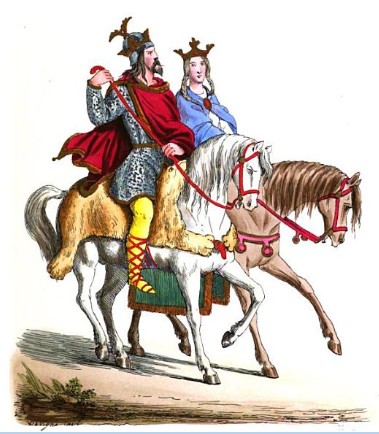[Baldwin I of Flanders and Judith of France, 1849, Félix de Vigne]
[Album du cortége des Comtes de Flandre, source: Wikimedia Commons]
She was only twelve when she became the second wife of Æthelwulf of Wessex in 855. Her father, perhaps remember what his own mother, Judith of Bavaria, had gone through as the second wife of a king who already had heirs, hedged the marriage around with as many safeguards as possible, including having her crowned and anointed as Queen. The wives of the kings of Wessex were traditionally not queens, but merely king’s wives. This is also the first recorded instance of the anointing of an early medieval queen.
When Æthelwulf died three years later, Æthelbald, his son by his first wife, married her, probably in order to keep the alliance with her father and the prestige that came with being connected to the Carolingians. Many at the time condemned the marriage.
Two years later, in 860, Æthelbald died, leaving Judith twice widowed before the age of 20. Since she had no children she had no ties to Wessex at this point either. She sold her properties there and returned to France. Her father sent her to the monastery at Senlis, probably hoping to arrange another marriage for her. Judith, however, had other ideas. Near Christmas 861 she ran off and married a count named Baldwin.. Her father was furious and tried to get them excommunicated, forcing them to flee first to Judith’s cousin, Lothar,* and then to Pope Nicholas I for protection. It was Nicholas who persuaded Charles to accept the match and make Baldwin the Count of Flanders. The couple was officially married in 863 and had 3 children together. We don’t know when Judith died, only that she was still alive in 870.
*He was, by the way, in the middle of his own marriage problems.
Stafford, Pauline. Queens, Concubines, and Dowagers: the King's Wife in the Early Middle Ages. Athens, Georgia: University of Georgia Press, 1983.
Judith of Flanders - Wikipedia
Æthelwulf of Wessex - Wikipedia
Æthelbald of Wessex - Wikipedia
Baldwin of Flanders - Wikipedia

 RSS Feed
RSS Feed
